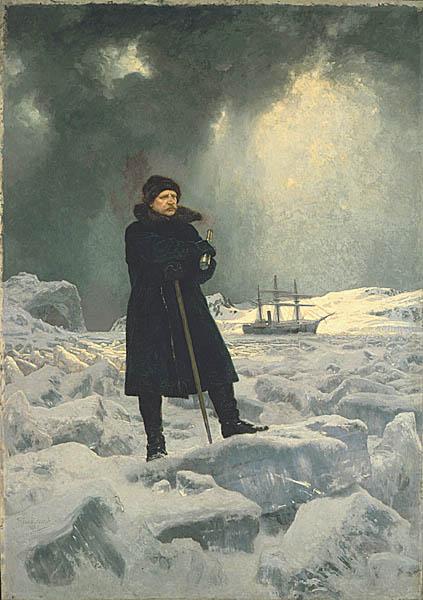
Geologen, upptäcksresanden och polarforskaren Adolf E, Nordenskiöld upptäckte stora järnblock på Diskoön utanför Grönlands västkust. Det största blocket, som du har framför dig, lyfter under svåra omständigheter ombord på ett fartyg från marinen och togs till Sverige några år efter upptäckten.
Upptäckten var en geologisk sensation på den tiden då geologer först trodde blocken var järnmeteoriter. Senare kunde det visas att järnblocken bildats för ungefär 60 miljoner år sedan genom naturlig reduktion som en följd av en reaktion mellan basaltmagma och organiskt kol från sediment, i princip samma reaktion som används vid järnframställning ut malm i en masugn.
Naturligt förekommande block av gediget järn är väldigt sällsynta och återfinns bara på ett fåtal platser runt jorden.
För att logga den här cachen ska du svara på två frågor:
* När upptäcktes blocket?
* Hur mycket väger det?
Svaren finns på en informationsskylt bredvid blocket.
Valfritt, men mycket uppskattat: Fotografera blocket (gärna med dig själv, men det är inte nödvändigt) och bifoga loggen.
Det enklaste sättet är att lämna ditt svar med Certitude. Klicka på loggan nedan, logga in i applikationen, och ange årtalet följt av vikten i ton, enbart siffror.
Exempel: om årtalet är 1989 och vikten är 10 ton mata in 198910 som svar.

Lämna ditt svar med certitude.
Logga ditt besök när du fått godkänt och ditt användarnamn finns med i "Certified solvers", inga svar i loggarna, tack! Bifoga eventuell bild med loggen!
Om du inte kan/vill använda certitude så skicka ett mail till mig och invänta godkännande innan loggning. Jag är väldigt tacksam om du bockar för "I want to send my email address along with this message", då går det lite fortare för mig att svara.
OBS! Om du inte svarar på frågorna på något av dessa sätt kommer din logg att raderas utan varning!
Geologist, explorer and polar researcher Adolf E, Nordenskiöld discovered large iron blocks on Disco island off Greenland's west coast. The largest block, which you have before you, were under extremely difficult circumstances lifted onboard a ship from the Swedish navy and carried to Sweden some years later.
The discovery was a geological sensation at the time, when geologists first believed the blocks to be iron meteorites. Later it was proved that the iron formed at about 60 million years ago by natural reduction by reaction between basalt magma and organic carbon from sediments, basically the same reaction used in iron production in a blast furnace
Naturally occurring blocks of solid iron, or native iron, is very rare and is found only in a few locations around the globe.
To log this cache you must answer two questions:
* When was the block discovered?
* How much does it weight?
The answers are found on an information sign next to the block.
Optional, but highly appreciated: Take a photo of the block (feel free to be in the picture!)
The simplest way to provide your answer is by using Certitude. Click on the banner below, log in to the website, and give the year followed by the weight as a solution, only numbers
Example: If the year is 1989 and the weight is 10 tonnes give 198910 as an answer.

Leave your answer with certitude.
Log your visit when your answer is approved and your GC.com handle is in the list of "certified solvers", no answers in the logs, please! Attach the photo to the log if you have taken one,
If you don't want or can use certitude you have to mail me the answers and wait until approval before logging. Please check the option "I want to send my email address along with this message" for a fast answer. Attach the picture with the log.
Note! failure to submit your answers in any of these ways will get your log deleted without notice.